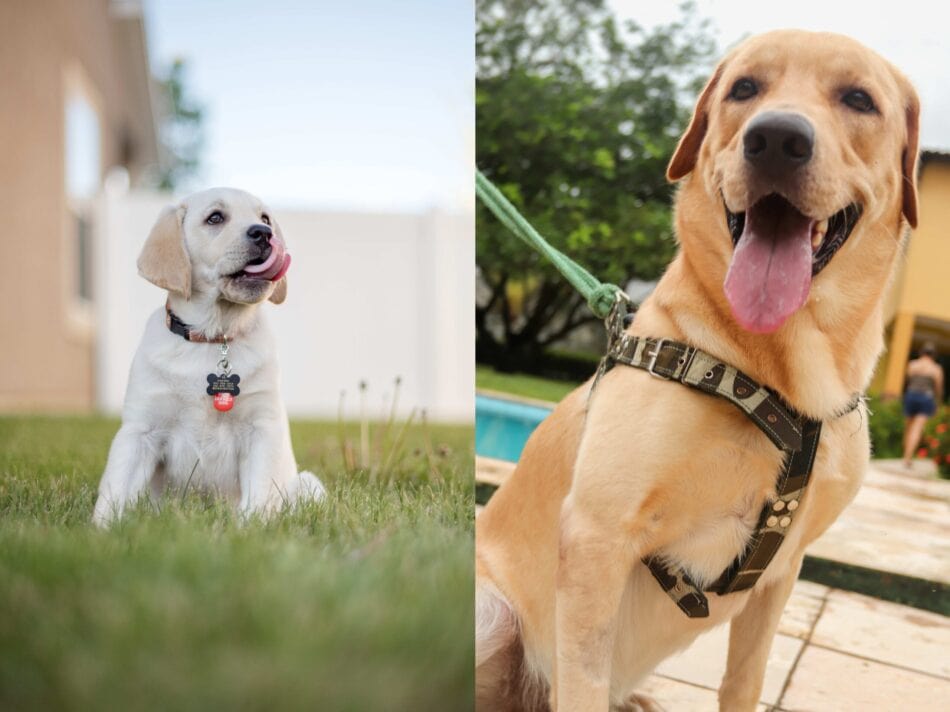Is your Labrador getting out of hand? You needn’t worry. A harness can help you keep your pup safe and under control. Today, we will discuss the various benefits of using a harness for your Labrador, and how it can help you keep your pup safe and healthy. What are you waiting for? Let’s dive right in!
Labradors are an incredibly popular breed of dog, and many dog owners choose to include them in their lives. Taking proper care of a Labrador is essential to their health and well-being, and that includes having the right tools on hand. A harness is one of the most important tools for your Labrador’s safety when out for walks or other activities.
In this guide, we’ll explore the many benefits of using a harness for your Labrador. We’ll cover why it’s important to use a harness when out with your Lab, as well as how to choose the right one for them. We’ll also discuss some tips and tricks on how to use a harness safely and effectively with your pup. Finally, we’ll provide you with information on where you can find good quality harnesses for your Lab. By the end of this guide, you will have all the knowledge you need to make an informed decision on whether or not a harness is right for your canine companion.
The Advantages of Using a Harness for Your Labrador Retriever
Labradors are strong and active dogs, making them difficult to control with a traditional collar. A harness offers many advantages to ensure proper canine care, keeping your beloved Labrador safe and comfortable. Here are some of the main benefits of using a harness for your Lab:
- Better control over your dog – Harnesses provide an extra level of security mainly because they offer good control versus a regular collar. The design of the harness spreads the pulling force over a larger area of your Lab’s body which can reduce the risk of injury while walking or playing with other dogs. If you have problems controlling your Labrador Retriever, this is definitely an advantage worth considering as it can help you maintain better control over him/her.
- Improved safety – Along with better control, opting for a supportive body harness or head halter also reduces the risk of tracheal or neck injuries by limiting where the lead attaches on their body or head respectively.
- More comfort – Your Lab will be more comfortable when wearing a harness due to its general fit and design that allows for little strain on the neck and back areas most common when wearing a traditional collar. With gentler materials such as lightweight mesh and adjustable components, these types of harnesses better accommodate activities like hiking, Swimming and other everyday activities; perfect for active Labradors!
4 Reduced Risk Of Injury – By limiting strain on certain areas with its design, use of suitable materials like breathable neoprene fabrics can help keep your buddy from getting injured in any manner during physical activities like running, which could otherwise result in back strains or fatigue-related issues caused by consistent pressure around their necks due to regular collars.
Reducing strain on the neck and spine
Using a harness for your Labrador is an excellent way to reduce strain and even prevent injury in the neck, spine, and other delicate areas. A harness can distribute the pressure of leash pulling over a wider area than if you were using a collar, which applies pressure only to the neck. You may find that your Labrador enjoys being able to run around with more freedom when wearing a harness.
A well-designed harness can help keep your dog under control by providing greater control in difficult situations. With extra control points, you will have an easier time correcting any misbehavior without resorting to more aggressive methods. Additionally, some harnesses come with adjustable straps that allow for a custom fit according to your beloved companion’s body shape and size, providing both comfort and safety as you embark on activities together.
Controlling pulling behavior
One of the challenges associated with Labrador retrievers is that they can be strong pullers when on the leash, particularly when excited. A harness is one potential solution for reducing and controlling pulling behavior. A harness will provide additional control by placing pressure across the chest rather than just on the neck. This is especially important if your Labrador has any breathing or tracheal problems, as a traditional leash and collar combination can further aggravate these issues. A well-fitted harness should provide equal distribution of pressure around both shoulders, allowing for greater comfort and balance during walks.
In addition to providing more control, a harness can act as a reward for good behavior. Wearing a properly fitted harness should be comfortable for your Labrador and some dogs may even start associating it with treats or fun activities like going outside, which will help reduce pulling behavior in the long run. Be sure to use positive reinforcement techniques to encourage your dog’s compliance while walking so that they will form positive associations with wearing their harness in the future. As always, try to keep walks short and enjoyable if you want your Labrador to enjoy wearing their harness!
Preventing slipping and escaping
When it comes to safety, the most important feature of a properly fitting harness is that it prevents the dog from slipping out and engaging in unwanted activities or getting injured. This is especially important if your Labrador loves to explore and loves to run around. A well-fitted harness ensures that they can’t easily escape while outdoors, which can prevent them from running into potentially dangerous areas or away from you altogether.
Additionally, many harnesses come with features that make it easier for your dog to be spotted at night, such as reflective patches or illuminating strips. This makes it safer for your furry friends during night walks or late-night trips outdoors.
Supporting mobility and health
Using a harness for your Labrador can support mobility and health, facilitate activities like running, and provide gentler, more comfortable control than using a collar. Although Labrador Retrievers are known for their wild enthusiasm for physical activity, it is important to research which style of harness would be most comfortable and supportive for your individual dog. Many harness styles can cause neck or shoulder strain if not adjusted properly to fit your dog’s size and body type.
A good quality dog harness should be adjustable enough to provide a snug but comfortable fit as well as secure buckles or snaps. The straps should also be made from durable materials like nylon webbing or breathable mesh fabric so the dog won’t overheat while wearing it. A properly fitting harness should allow you to easily control the dog’s movement while preventing accidental death by hanging or strangulation caused by getting stuck on something while walking off leash. This can be especially important when letting your Labrador loose in an uncontrolled open space such as an unfenced beach or road side field.
It’s also important to pick a design that offers freedom of movement during activities such as puppy agility classes and running with your lab without hampering its natural range of motion in any way – all the while keeping them safe if on active trails near traffic! Finally, look for features like padded areas at pressure points like shoulders and chest, which provide added comfort for the Lab by distributing tug tension evenly across the body avoiding hotspots and bruises when pulling too strongly accidentally on reactive moments during walks (or fun activities!).
III. How to Choose the Right Harness for Your Labrador Retriever
Choosing the right harness for your Labrador Retriever is important for both comfort and safety. It’s important that the harness fits properly and is adjusted correctly. To ensure that you get the right fit, measure your dog around their girth (the widest part of their body) with a tape measure. Also, read through the manufacturer’s instructions and look at size charts to ensure you get a good sizing before you buy.
The best way to find a good-fitting harness is to first try it on without attaching any clips or buckles. The strap should be loose enough so they can move freely in it, but not too loose that they can pull out of the buckle when running or playing with other dogs. When trying on a harness make sure that your Labrador has room between the straps and their chest so they can comfortably lift their legs when walking.
Not all harnesses are adjustable and this needs to be taken into account when purchasing one for your Labrador Retriever. In addition to being adjustable, it also needs to be comfortable for them – look for one with breathable materials such as webbed nylon or fleece-lined metal buckles rather than plastic ones, as these provide better ventilation around the chest area and avoid creating irritation from sweating or extreme temperatures in long summers or colder winters. The harness should also be lightweight so that uncomfortable pulling isn’t created while they are running around outside with you.
Considerations such as size, comfort, and functionality
Before you buy a harness for your Labrador, there are several important considerations to take into account so as to ensure you select the right one. Thinking about factors such as size, comfort, and functionality can help you decide which harness is the most suitable for your pup.
Size: it is crucial to pick a harness that fits correctly and comfortably on your Labrador’s body. To find one in the right size, you need measurements of the widest circumference at mid-neck, and at mid-chest area. Make sure there is an allowance of 1-2 fingers between the strap and your dog’s neck or chest for proper fitting; if it’s too tight or too loose, it lessens its effectiveness.
Comfort: an uncomfortable harness can make walks difficult for both of you! As Labradors generally have strong neck muscles and wide chests, they require comfortable harnesses with adjustable straps that will not rub against the skin or put pressure on certain areas that can hurt their bodies.
Functionality: when choosing a dog harness for your Labrador, its purpose should be taken into account – if it is to train them out of pulling habits or only serve as identification when outdoors? Some walking harnesses have specifically placed attachment points accommodating different activities – some have a single attach point at the chest while others have two at both front and back. Additionally, breathable types made from materials such as neoprene are best if frequent runs are taken with your pup.
Tips for properly fitting a harness
When you’re selecting a harness for your Labrador, it is important that you properly fit the harness for your pup’s size, shape and body type. The harness should be snug against the body but not too tight, as this could cause discomfort to your pup. Below are five tips for properly fitting a harness for your Labrador:
- Measure accurately: Measure around the widest part of the chest which is usually just behind the front legs. Add a few inches to ensure a comfortable fit.
- Check buckle and straps: Make sure that buckle clips are secure and won’t come off easily when pressure is applied and double check all straps to be sure they are fastened tightly without being overly restrictive.
- Comfort first:The harness should be snug enough that it stays in place but not too tight as to cause discomfort or restrict movement of your dog’s shoulders or arms.
- Test the fit: Put on the harness, adjust accordingly and have someone gently tug on it from different angles to test how securely it will stay in place, especially when pulling against strong forces such as pulling or running quickly with or without leash attached.
- Make adjustments if needed: If necessary make adjustments by either loosening or tightening clips before finalizing purchase and taking home with you.
How to Train Your Labrador Retriever to Use a Harness
It is important to ensure that your Labrador retriever feels comfortable wearing a harness before you use it for outings. Before putting the harness on for the first time, introduce it to your pup in its most relaxed state at home. Let them examine and sniff the harness so they become more familiar with it. Then, make sure to reward them with treats as an expression of positive reinforcement when putting on and taking off the harness, follow this step until the dog is relaxed with the item.
Furthermore, if you plan on taking your pup out for walks in their new harness, be sure to start indoors first and then slowly transition outside when they are ready. Be patient, take your time and make it a fun experience by rewarding them every few steps at first. As your dog’s comfort level increases, you can start increasing walking distances and increase rewards less frequently as needed.
By following these steps carefully, you can ensure that both you and your Labrador will feel comfortable trusting and using a new tool together when out on walks or hikes!
Introduction and familiarization with the harness
Labradors are intelligent and energetic dogs that make excellent companions. However, like all other breeds, they require certain materials in order to be properly trained and taken care of. One of the most important pieces of equipment for them is a harness, which can improve their safety outside, help with basic training, and decrease their energy level when needed. When looking for a harness for your Labrador, you should consider several factors such as size and type as well as the importance of familiarization with the new equipment.
In order to use a harness most effectively with your Labrador, it is essential to introduce them to it properly and ensure that they are comfortable with wearing it right away. Gradually introducing the harness will help prevent any feeling of restriction or discomfort during long-term use. Present it gently without any aggression or force, then allow the Labrador plenty of time to become accustomed to having it on them. If your dog begins panting or struggling when wearing the harness too quickly or appears extremely uncomfortable or resistant after introducing it multiple times, then take longer breaks between initial presentations or find a different model that is more suitable for your pet’s individual needs.
Gradual training and positive reinforcement
For Labradors, harnesses offer many benefits over traditional collars and should be strongly considered when exploring different methods of walking and training your pup. When introducing a harness to your Labrador, it is important to use gradual training and positive reinforcement to help them adjust.
Start by introducing the harness in the home with plenty of praise and treats. Allow them to investigate the item with their nose before putting it on – some labs may be apprehensive of the new piece of gear so let them take their time. Place the harness gently around their body using soothing tones before fastening it securely in place. It is important that your Labrador have time to get used to working with a leash while wearing the harness – start indoors with minimal distractions from other pets or people.
Using positive reinforcement, such as treats or verbal praise, work towards reaching small milestones such as simply wearing the harness for increasing periods of time each day, or walking four steps then rewards for good behaviour when out on walks can help build a trusting relationship between handler and pup as well as encourage obedience in new environments. As you progress, adding extra levels of distractions such as other people or animals can help better prepare your Labrador for trickier areas like parks full of dog walkers and bicycles or busier roads. Consulting a trainer or professional behaviourist may also be beneficial if you are having difficulty progrssing with training your labrador using a harness.
Handling and adjusting the harness
The right-sized harness should be snug and fit comfortably, ensuring your Labrador has plenty of mobility and breathing space. A properly fitted harness should not constrict freedom, rub or restrict movement in any way during use. It is essential to ensure that the straps are firmly secured for your Labrador’s comfort and safety, but not so tight as to cause discomfort or abrasions.
To ensure a correct fit, it is important to take precise measurements from your Labrador’s chest circumference and neck size before purchasing a harness. Use a fabric measuring tape pulled snugly around the part of the chest where the harness will go, as well as at the base of the neck directly behind and above the shoulders – roughly where the collar of their shirt would usually go. Taking these measurements and using them in conjunction with manufacturer’s sizing recommendations will help you select the right-sized harness for your Labrador’s unique shape and size.
Once you have purchased a suitable harness chose one with adjustable straps to enable sizing adjustment when wearing clothing such as coats or jackets or when your labrador’s body size changes with age, weight gain or pregnancy if female. The hind leg loops/straps can be adjusted separately from those which go around their chest/front legs to provide a reasonably snug yet comfortable fit for different body shapes whilst still allowing ample range for movement during exercise activities. It is advisable to leave some allowance in case adjusting needs do arise due to unforeseen weight gain or anything else which might impact your pooch’s desired level of comfort over time.
Conclusion
In conclusion, using a harness is an effective way to keep your Labrador safe while allowing them to enjoy the freedom of exploration. It is important to choose a comfortable and well-fitting harness and to take the time to train your dog so they are used to wearing and responding appropriately when pulled. With regular practice, you can help your Labrador stay safe and secure during daily walks or trips outdoors.
Ultimately, the best tool for managing your Labrador’s behavior will be consistency and patience with consistent rewards for good behavior. While it may take some time for both you and your dog to become accustomed to using a harness, it can ultimately make the walking experience more enjoyable for both of you.
FAQ’s
Are harnesses good for Labradors?
Yes, harnesses can be a good option for Labradors as they distribute pressure more evenly and can prevent neck injuries.
Should you use a collar or a harness for a Labrador?
It depends on the individual dog and their specific needs, but harnesses are generally recommended for Labradors.
Do dogs behave better with a harness?
Not necessarily, but harnesses can make it easier to control and manage a dog’s behavior by giving the owner more control.
Do vets recommend collars or harnesses?
Many vets recommend harnesses over collars, especially for dogs with neck or breathing problems.
What are the pros and cons to a dog harness?
Pros include increased control and reduced risk of neck injuries, while cons can include difficulty putting on and potential for rubbing or chafing.
Is it OK to leave harness on dog?
It is generally not recommended to leave a harness on a dog for extended periods of time as it can cause discomfort or rubbing.
Do harnesses stop dogs from pulling?
Not necessarily, but they can make it easier to control and manage a dog’s pulling behavior.
What kind of leash is best for Labrador?
A sturdy, durable leash that is at least six feet long is typically recommended for Labradors.
Can labs be trusted off leash?
It depends on the individual dog and their training, but Labradors are generally known for their friendly and obedient nature.
Why harness is best for dogs?
Harnesses can be better for dogs because they distribute pressure more evenly and can prevent neck injuries, especially for dogs that pull or have neck or breathing problems.
See Also-
- Best brush for Labrador
- Best collar for pulling Labrador
- Best crate for labrador puppy
- Best dog bed for Labrador
- Best dog food for labrador retriever


